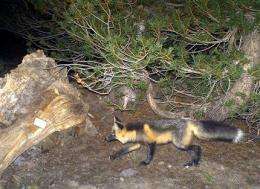2 more rare red foxes confirmed in Sierra Nevada

(AP) -- Federal wildlife biologists have confirmed sightings of two more Sierra Nevada red foxes that once were thought to be extinct.
Scientists believe the foxes are related to another that was photographed this summer near Yosemite National Park. More importantly, they say, DNA samples show enough diversity in the Sierra Nevada red foxes to suggest a "fairly strong population" of the animals may secretly be doing quite well in the rugged mountains about 90 miles south of Reno.
The first confirmed sighting of the subspecies in two decades came in August when a remote camera captured the image of a female fox in the Humboldt-Toiyabe National Forest near Sonora Pass.
Forest Service officials confirmed Friday that two more foxes - one male and one female - were photographed in September in the neighboring Stanislaus National Forest, about 4 miles from the original.
That indicates there is the "continued persistence of a genetically unique population of Sierra Nevada red fox in the southern Sierra Nevada, rather than a single individual," the agency said.
The DNA samples were obtained from fox feces, or scat, collected at the sites where the two most recent animals were spotted. They were caught on film by motion-activated cameras triggered when the bait - in this case, a sock full of chicken - was disturbed.
"There's enough diversity in the DNA that we think there is a fairly strong population there after not showing up in this isolated area for years and years," Forest Service wildlife biologist Diane Macfarlane said Friday.
"It shows the male individual has some relationship to that initial female. The data isn't strong enough to say if it was a mother or father or sibling, but it is some level of relationship - aunt, cousin, uncle," she told The Associated Press.
"The good news is we definitely have a male and female. We know there are breeding possibilities and there could be others," said Macfarlane, who leads the agency's regional program on threatened, endangered and sensitive species based in Vallejo, Calif.
"We anticipate getting a lot more information in the future as we begin to focus serious, additional efforts there," she said.
This particular red fox subspecies - or geographically distinct race - is one of the rarest, most elusive and least-known mammals in California and the United States, agency officials said.
Once widespread throughout California's mountains, it has become very rare in recent decades, with only a single known population of fewer than 20 individuals at the north end of the Sierra near Lassen Volcanic National Park about 100 miles northwest of Reno.
The Forest Service has expanded the survey effort in recent months in conjunction with researchers at the National Park Service, California Department of Fish and Game, UC-Davis and Cal Poly-San Luis Obispo.
Adam Rich, a wildlife biologist for the Stanislaus National Forest, worked with a team of high school volunteers to collect scat at the two new photo locations.
Macfarlane said it was a good example of how federal agencies can work in concert with other researchers to find "simple and cost effective ways to manage and monitor rare wildlife."
"We are really ramping up our survey efforts, working with universities and others, to go look for things in places where we haven't looked before," she said. "And we are finding more things as our techniques become more and more sophisticated."
"For wildlife biologists, these types of findings are the highlight of our career," she said. "I get goose bumps just talking about it."
©2010 The Associated Press. All rights reserved. This material may not be published, broadcast, rewritten or redistributed.
















